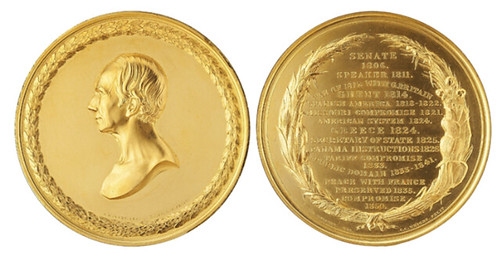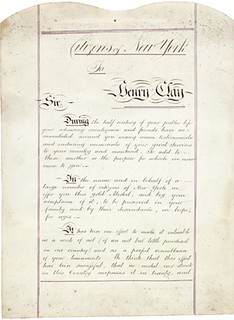
PREV ARTICLE
NEXT ARTICLE
FULL ISSUE
PREV FULL ISSUE
MORE ON THE GOLD HENRY CLAY U.S. MINT MEDAL
Last month we discussed the amazing U.S. Mint gold medal presented to Henry Clay; here an excerpt from a new article by Paul Gilkes of
Coin World published on July 15, 2016. -Editor

A nearly 30-ounce duplicate gold medal struck as a replacement for the medal originally presented in 1852 by citizens of New York to statesman Henry Clay but subsequently stolen will be offered at auction Sept. 17 in Dallas. The committee of New York citizens commissioned the medal recognizing Clay’s achievements as “The Great Compromiser.” The nearly half-inch-thick, 90-millimeter medal, struck by the U.S. Mint, is being offered in a “Lincoln and His Times” sale, a joint auction by Heritage Auctions and the journal The Rail Splitter in recognition of the 20th anniversary of The Rail Splitter’s May 18, 1996, sale in New York. With gold closing on the London market July 14 at $1,323.60 per ounce, the intrinsic value of the gold medal, its precious metal value alone, is nearly $40,000.
According to an article by Georgia S. Chamberlain in the January 1961 issue of the American Numismatic Association journal, The Numismatist, the gold for the medal cost $400, the silver casing $75, the cost of cutting the dies $1,600, and the cost of design and other “incidental” expenses, another $400. Ohio sculptor Thomas Dow Jones is credited with executing the obverse design based on an 1850 bust of Clay by Mahlon Pruden, a sculptor from Lexington, Ky., from when Clay was 73 years old. Another Ohio sculptor, William Walcutt, rendered the reverse design for the gold medal. The dies were cut at the U.S. Mint in Philadelphia by Charles Cushing Wright. The obverse medallic portrait is encircled by a wreath. The reverse design depicts a wreath with cotton on one side and corn on the other, within which are inscribed Clay’s achievements in public service, including the Compromise of 1850, a series of laws dealing with the issue of slavery which staved off the American Civil War for 10 years. According to R.W. Julian in Medals of the United States Mint: The First Century 1792-1892, Wright petitioned the Treasury Department in December 1851 and was granted permission to have the Clay medal struck in gold at the Mint. Permission was subsequently granted for the production of 150 bronze duplicates. A single example is known struck in tin.
This is an absolutely amazing medal, together with stunningly elaborate packaging. It's sure to bring a record price. But who will
step up to become its next caretaker? Stay tuned, and be sure to read the complete article online for more background on the medal's
theft and replacement. -Editor
To read the complete article, see:
To read the earlier E-Sylum article, see:

Wayne Homren, Editor The Numismatic Bibliomania Society is a non-profit organization promoting numismatic literature. See our web site at coinbooks.org. To submit items for publication in The E-Sylum, write to the Editor at this address: whomren@gmail.com To subscribe go to: https://my.binhost.com/lists/listinfo/esylum All Rights Reserved. NBS Home Page Contact the NBS webmaster 
|
